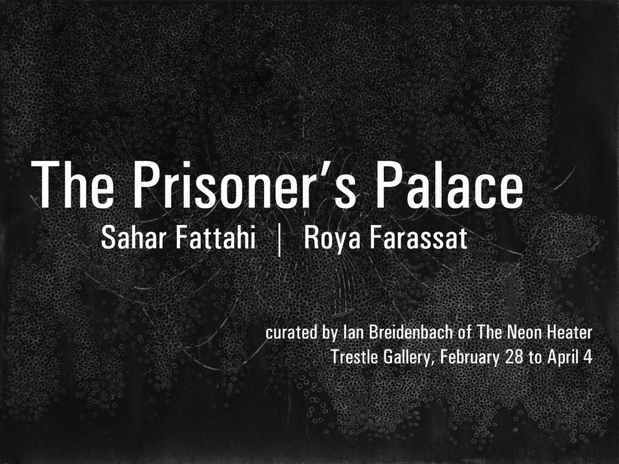Roya Farassat and Sahar Fattahi “Prisoner’s Palace”
Trestle Gallery

This event has ended.
Curated by Ian Breidenbach of The Neon Heater
Trestle Gallery is pleased to present The Prisoner’s Palace, an exhibition of recent works by the Roya Farassat and Sahar Fattahi, as part of the yearlong series Artist-Run 2020. The Prisoner’s Palace is curated by Ian Breidenbach of The Neon Heater in Findlay, OH.
— For a moment the cell had a window and I could see all the people who passed by —
During the controversial fifty-year reign of the Pahlavi Empire beginning in 1925, Iranian women enjoyed considerable progress and freedom. Women were no longer required to wear their veils, they gained the right to vote, they were offered education, earned equal salaries, and were able to hold public office. However, when the Shah was deposed in 1979 by Ruhollah Kohmeini, the pro-Western monarchy was replaced with an anti-Western Theocracy. Under this new institution of Islamic Law, many of those rights and freedoms were revoked. They were once again required to cover themselves in public. The Family Protection Law, which in 1967 raised the marriage age to 18 and put restrictions on polygamy and temporary marriage, was suspended, and replaced with traditional Islamic religious rules.
— but the window was walled up and a light was hung from the ceiling —
Fattahi’s the fragmentation of the chandelier, done by middle finger is a protest work, using only her middle finger to paint with a black dye the baubles and jewels that would usually adorn this luxury item. For Fattahi, the systems of government and religious oppression are depicted in the structure of a chandelier; as an armature of oppression with an unattainable void in the center. The arms keep everything affixed in their place.
— so I made friends with the insects that scurried across the floor… I gave them names, and titles and roles to play —
In the twenty pieces of Farassat’s Menagerie, she creates through the erasure of the paper’s dark pigment. Using bleach to create random symmetrical forms, she then paints adornments to turn the ghostly figures into a retinue of archetypal characters. Characters which are pulled from all manner of fictional realms; from the historical (the High Priestess, The Emperor) to the folkloric (the Fortune Teller, the Angel) and the contemporary (the Bully, the Superhero).
— the light illuminated everything except the center of the room, I spent all of my time in this dark void —
All of the these works revolve around the central floor piece, Fattahi’s “The Impure Body at The Ritual” a foam mattress pad stretched on a frame that hovers a few inches above the ground, undulating on the edges and suggesting bodily forms. A layer of thin black mesh wraps the body of the work. The mesh makes its impact on the surface as the piece appears black from the distance but gradually reveals the spills of red as the viewer arrives upon it; a commentary on religions’ twisted response to the feminine body and its natural functions.
— from here in my prisoner’s palace I dream —
In video works titled Revolt I and II, the armature sings and the armature burns.
Roya Farassat is a visual artist, born and raised in Iran. She moved to New York prior to the Islamic revolution and received my BFA from Parsons School of Design. Her paintings and sculptures are largely influenced by a culture and tradition that embraces a distorted sense of reality. The themes of female Identity, isolation, violence and oppression animates my work.
Sahar Fattahi is an Iranian-American painter-sculptor who has been actively engaged in feminist approaches through her studio/ research for two decades. Her work has been exhibited for more than a decade in Iran and the US.
Ian Breidenbach is a conceptual artist, curator and connector. In 2012, he founded The Neon Heater in Findlay, OH as a space for contemporary art in a rural setting. He has curated over 120 exhibitions through the gallery, including a series of exhibitions titled The Temperature. The Temperature took place between September 2018 and May 2019 and consisted of 25 interconnected exhibitions at artist-run spaces around the country, sequentially unravelling a conceptual narrative taking the temperature of the art world and the socio-political climate.
Media
Schedule
from February 28, 2020 to April 04, 2020
Opening Reception on 2020-02-28 from 19:00 to 21:00